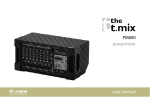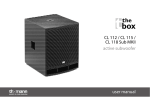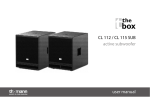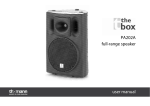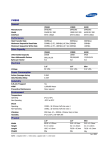Download PM800 powermixer user manual
Transcript
PM800 powermixer user manual Musikhaus Thomann e. K. Treppendorf 30 96138 Burgebrach Germany Telephone: +49 (9546)-9223-0 email: [email protected] Internet: www.thomann.de 17.11.2011 Table of contents Table of contents 1 General notes............................................................................................................................................... 4 2 Safety instructions..................................................................................................................................... 6 3 Installation.................................................................................................................................................. 3.1 Pin assignment.................................................................................................................................. 3.2 Tips on speaker positioning......................................................................................................... 3.3 Connection diagram....................................................................................................................... 4 Control elements..................................................................................................................................... 15 5 Technical specifications....................................................................................................................... 5.1 Preset list............................................................................................................................................. 5.2 Features............................................................................................................................................... 5.3 Block diagram.................................................................................................................................... 6 Protecting the environment.............................................................................................................. 33 10 10 13 14 25 28 30 32 PM800 3 General notes 1 General notes This user manual contains important information on the safe operation of the device. Read and follow all safety notes and all instructions. Save this manual for future reference. Make sure that it is available to all persons using this device. If you sell the device to another user, be sure that they also receive this manual. Our products are subject to a process of continuous development. We therefore reserve the right to make changes without notice. Symbols and signal words This section gives an overview of the symbols and signal words used in this user manual. powermixer 4 General notes Signal word Meaning DANGER! This combination of symbol and signal word indicates an immediate dangerous situation that will result in death or serious injury if it is not avoided. CAUTION! This combination of symbol and signal word indicates a possible dangerous situation that can result in minor injury if it is not avoided. NOTICE! This combination of symbol and signal word indicates a possible dangerous situation that can result in material and environmental damage if it is not avoided. Warning signs Type of danger Warning – high-voltage. PM800 5 Safety instructions 2 Safety instructions Intended use Use the device only as described in this user manual. Any other use or use under other oper‐ ating conditions is considered to be improper and may result in personal injury or property damage. No liability will be assumed for damages resulting from improper use. This device may be used only by persons with sufficient physical, sensorial, and intellectual abilities and having corresponding knowledge and experience. Other persons may use this device only if they are supervised or instructed by a person who is responsible for their safety. DANGER! Electric shock caused by high voltages inside Within the device there are areas where high voltages may be present. Never remove any covers. There are no user-serviceable parts inside. powermixer 6 Safety instructions DANGER! Electric shock caused by short-circuit Always use proper ready-made insulated mains cabling (power cord) with a pro‐ tective contact plug. Do not modify the mains cable or the plug. Failure to do so could result in electric shock/death or fire. If in doubt, seek advice from a regis‐ tered electrician. DANGER! Electric shock caused by high voltages at the power amplifier output The output voltages of modern high-performance amplifiers may result in death or serious injury. Never touch the bare ends of loudspeaker cables when the amplifier is on. PM800 7 Safety instructions CAUTION! Possible hearing damage With loudspeakers or headphones connected, the device can produce volume levels that may cause temporary or permanent hearing impairment. Do not operate the device permanently at a high volume level. Decrease the volume level immediately if you experience ringing in your ears or hearing impairment. NOTICE! Risk of fire Do not block areas of ventilation. Do not install the device near any direct heat source. Keep the device away from naked flames. powermixer 8 Safety instructions NOTICE! Operating conditions This device has been designed for indoor use only. To prevent damage, never expose the device to any liquid or moisture. Avoid direct sunlight, heavy dirt, and strong vibrations. NOTICE! Power supply Before connecting the device, ensure that the input voltage (AC outlet) matches the voltage rating of the device and that the AC outlet is protected by a residual current circuit breaker. Failure to do so could result in damage to the device and possibly injure the user. Unplug the device before electrical storms occur and when it is unused for long periods of time to reduce the risk of electric shock or fire. PM800 9 Installation 3 Installation Unpack and check carefully there is no transportation damage before using the unit. Establish all connections as long as the unit is switched off. Use the shortest possible highquality cables for all connections. 3.1 Pin assignment You can use XLR and phone jack connectors with either balanced or unbalanced wiring. powermixer 10 Installation XLR connection for signal in and outputs XLR mounting sockets provided for signal inputs. XLR mounting plugs provided for signal out‐ puts. Drawings and descriptions explain the pin assignment. Balanced wiring: 1 Ground, shielding 2 Positive signal (+) 3 Negative signal (–) Unbalanced wiring: 1 Ground, shielding 2 Signal 3 bridged with Pin 1 PM800 11 Installation 1/4" connectors for signal in and outputs Drawings and descriptions explain the pin assignment of 1/4" connectors. Unbalanced wired 1/4" TS jack: 1 Signal 2 Ground, shielding Unbalanced wired 1/4" TRS jack: 1 Signal 2 Ground, shielding powermixer 12 Installation Balanced wired 1/4" TRS jack: 1 (Tip) Positive signal (+) 2 (Ring) Negative signal (–) 3 (Sleeve) Ground, shielding 3.2 Tips on speaker positioning We recommend you to set up the speakers in a way, that the sound signals can reach the audi‐ ence unobstructedly. Often tripod mounting is a good way to maximise dispersion and range. Always use high grade cable to connect your equipment. Otherwise you won't reach max‐ imum sound quality. For optimum results both impedance and power handling of the speakers must match the requirements of the amplifier. Always follow the technical specifications of the speakers! The overall impedance of the connected loudspeakers must not deceed the minimum output impedance of the amp. The power handling of the speakers should be above the amp's output power. PM800 13 Installation 3.3 Connection diagram Before connecting the device you have to make sure, that all units are switched off and its volume controls are turned down. 1. Connect line signal sources like CD or MP3 players to the unit. 2. Use high quality cables to connect passive speaker boxes to the output sockets (33). 3. Refer to the diagram shown above to connect further devices. 4. During operation turn the volume controls (LEVEL, 5) up to about 70 %. 5. Use the PFL function of the powermixer to adjust a suitable input level. Adjust the output level using the MAIN LEVEL control (19). powermixer 14 Control elements 4 Control elements Front panel SG/PEAK LED (1) This LED lights up in green when a signal is present in the LINE/MIC input. When the signal strength comes close to clipping, the LED turns red. Mono input channels (2) You can connect balanced, low impedance microphones or a low level signal to the XLR socket. Use the 1/4" TRS (LINE IN) socket to connect instruments with line level outputs like synthesizers, drum modules, preamps or the like. NOTE: Never connect an unbalanced microphone to the XLR socket. Otherwise both the mic and the mixer may be damaged. PM800 15 Control elements PHANTOM power switch and indicator (3) Pressing this switch will apply +15 V phantom power to the XLR sockets. This voltage is needed to supply condenser microphones. If you connect devices to the XLR sockets, that do not require phantom power, make sure phantom power is turned off. Otherwise the device may be damaged. With phantom power activated, the PHANTOM indicator lights up, otherwise the LED is off. DSP/FX AUX POST control (4) This potentiometer is "post fader" configured and controls the "FX SEND" level. Thus, the signal is affected by the channel fader. You can use the AUX1 signal to feed an external effect processor. LEVEL control (5) Use this fader to set the desired volume of the respective channel from — ¥ to +10 dB. 3 band equalizer Channels 1 - 8 offer a 3 band EQ, that provides a vast range for frequency correction. powermixer 16 Control elements HIGH (6) This is the treble control. Use it to reduce high frequency noises or to boost the sound of e.g. cymbals or high harmonics of voices. The gain range goes from -15 to +15 dB with a centre frequency of 12 kHz. MID (7) This is the mid range control. It can affect the most fundamental frequencies of all musical instruments and voices. An attentive use of this control will give you a very wide panorama of sound effects. The gain range goes from -12 to +12 dB with a centre frequency of 2.5 kHz. LOW (8) This is the bass control. It is used to boost male voices, kick drum or bass guitar. This will sig‐ nificantly enhance the sound of your PA system. The gain range goes from -15 to +15 dB with a centre frequency of 80 Hz. PM800 17 Control elements 1/8" phone jack input (9) Here you can connect a computer, MP3 or CD player using a 1/8" phone jack cable. LEVEL 9-10 (10) Use this control to adjust the level of both TAPE IN and 1/8" phone jack input (9). The adjust‐ able range goes from — ¥ to +10 dB. TAPE IN (11) Your power mixer offers 2 RCA inputs, where you can connect the R / L output of a tape machine, DAT or cassette recorder. TAPE OUT (12) Use these outputs to route the main output signal into a tape / DAT device or computer for recording. powermixer 18 Control elements 12 V LAMP (13) This XLR type lamp socket is provided for using a gooseneck lamp (PIN 1 = ground, PIN 2 = +). PHONES (14) Use this control to adjust the level of the PHONES output (32). MONITOR (15) Use this control to adjust the level of the MONITOR OUT (29). PM800 19 Control elements Graphic EQ (16) Your PM800 is equipped with a 7 band graphic EQ for the main mix. With these faders you can boost or attenuate the selected frequency by 15 dB with a fixed bandwidth. With all faders at centre position, the output response of the EQ is flat. The EQ function can be used, to shape the contour of the frequency spectrum and is available, as soon as the unit is pow‐ ered up. Output level LEDs (17) Use these 4 LEDs to monitor the output power. POWER indicator (18) This LED will light up as soon as the unit is turned on. LEVEL control (19) This control is used to adjust the overall output level from —¥ to +10 dB. DSP section Your PM800 features a special 100-preset digital effects section. You will read more about this later. powermixer 20 Control elements DSP display (20) Here the unit displays the number of the current preset. PROGRAM control (21) Adjust this control to select the desired effect out of 100 options available: Echo, vocal, plate, and versatile two-effect combinations. When you are satisfied with the chosen preset, push this knob to confirm this preset. DSP MUTE switch (22) Use this switch to activate or deactivate the effect section. For a more convenient operation of this function you can connect a foot switch (not supplied) to the "FOOT SWITCH" socket (28). CLIP/MUTE LED (23) This LED lights up when either the input signal is too strong, or when the DSP section is muted. AUX/DFX RET (24) This control is used to adjust the volume of the effects return signal. PM800 21 Control elements FX SEND (25) Use this 1/4" jack socket to feed the signal from AUX bus to external devices like effects unit or stage monitors. FX RETURN (26) This jack is used to return the signal processed by an external effects unit into the main mix. You can also use it as an extra auxiliary input, if you're running short of "normal" input chan‐ nels. COMP./LIM. switch and indicator (27) Set the COMP./LIM switch to ON position, to prevent your signals from exceeding a threshold that would cause distortion. If the input signal does not reach that threshold while this func‐ tion is activated, the indicator lights up in green. When the input signal becomes too strong and exceeds the threshold, the indicator turns red. FOOT SWITCH (28) You can connect an external foot switch (not supplied) to this 1/4" socket, to turn the built-in effects section on or off. MONITOR OUT (29) This socket is used to connect the input of an external monitor amp or active speakers. powermixer 22 Control elements MAIN OUT (30) Use this socket to feed the main mix signal to an external device like a power amp or the like. POWER switch (31) This switch is used to turn the unit on or off. PHONES output (32) This socket sends out the monitor signal to a pair of headphones. PM800 23 Control elements REAR PANEL OUTPUTS (33) Connect your speakers to these output sockets (SPK and 1/4" sockets). The minimum output impedance is 4 ohm. AC INLET (34) Connect the mains cable supplied here, to supply operating voltage to your powermixer. VOLTAGE SELECTOR (35) Use this switch to adjust the unit to the operating voltage available. When using the device in Germany, this switch must be in "220 - 240 V" position. Otherwise the unit will be dam‐ aged and you're facing risk of electric shock. Vents (36) These are the ventilation openings used for heat dissipation and cooling. They must never be obstructed during operation. Otherwise the unit may be damaged and you're facing risk of fire. powermixer 24 Technical specifications 5 Technical specifications Input channels Impedance Equalization Microphone inputs electronically balanced, discrete inputs Frequency response 20 Hz to 20 kHz, ± 3 dB Gain 50 dB Line inputs electronically balanced Frequency response 20 Hz to 20 kHz, ± 3 dB Gain 20 dB Microphone inputs 1.5 kohm All other inputs 10 kohm or above Tape out 1 kohm All other outputs 120 ohm Treble ± 15 dB @ 12 kHz Mid range ± 12 dB @ 2.5 kHz PM800 25 Technical specifications DSP section Main mix section Bass ± 15 dB @ 80 Hz Graphic EQ (sum) 7 band, 4/3 octave A/D and D/A converters 24 bit DSP resolution 24 bit Effect types Vocal, Small Room, Large Hall, Echo, Echo + Verb, Flange + Verb, Plate, Chorus + GTR, Rotary + GTR, Tremolo + GTR Presets 100 Controls/indicators Preset control, CLIP-LED, MUTE switch with LED indicator Noise (bus) Fader 0 dB, channels muted: -85 dBr (ref.: +4 dBu) Fader 0 dB, all input channels assigned and set to unity gain: -81 dBr (ref.: +4 dBu) THD S/N Monitor max. out +22 dBu unbalanced, 1/4" phone jack socket FX sends max. out +22 dBu unbalanced, 1/4" phone jack socket < 0.5 % @ 1 W power • < 1 % @ 250 W power Signal-to-noise ratio @ 1 kHz > 65 dB powermixer 26 Technical specifications Static power consumption Without signal < 50 W Output power 250 W RMS @ 1 kHz THD = 1 %, 4 ohm Last Frequency response Power supply voltage Dimensions/weight 20 Hz to 20 kHz, ± 3 dB AC 220-240 V / 110-127 V 50/60 Hz Dimensions 21.3" × 10.4" × 10.00" (540 × 265 × 256 mm) Net weight 24 lbs (10.9 kg) PM800 27 Technical specifications 5.1 Preset list No. Preset Description Parameter 00 ~ 09 Vocal Simulates a small room Decay time: 0.8~0.9 s Pre-delay: 0~45 ms 10 ~ 19 Small room Simulates a bright studio room Decay time: 0.7~2.1 s Pre-delay: 20~45 ms 20 ~ 29 Large hall Simulates a large acoustic room Decay time: 3.6~5.4 s Pre-delay: 23~55 ms 30 ~ 39 Echo Echo / delay effect Delay time: 145~205 ms 40 ~ 49 Echo + verb Echo & reverb combination Delay time: 208~650 ms Decay time: 1.7~2.1 s 50 ~ 59 Flange + verb Flanger effect & reverb combination Decay time: 1.5~2.9 ms Rate: 0.8 Hz~2.52 Hz 60 ~ 69 Plate Simulates classic, bright vocal plate powermixer 28 Decay time: 0.9~3.6 s Technical specifications No. Preset Description Parameter 70 ~ 79 Chorus + GTR Guitar effect: Chorus Rate: 0.92 Hz~1.72 Hz 80 ~ 89 Rotary + GTR Guitar effect: Rotary Modulation depth: 20~80 % 90 ~ 99 Tremolo + GTR Guitar effect: Tremolo Rate: 0.6 Hz~5 Hz PM800 29 Technical specifications 5.2 Features 250 W output power @ 4 ohm 8 line inputs with 1/4" sockets 8 balanced microphone inputs with XLR sockets 3 band EQ for each channel Monitor and effect send for each channel 7 band graphic main mix EQ Signal / peak indicator for channels 1 - 8 Tape out for recording Tape in with level control 1 AUX input with 1/8" socket LED display for output level Foot switch connector for switching DSP function on / off powermixer 30 Technical specifications Line outputs for main and monitor signal Selectable power supply voltage (AC 110~127 V or AC 220~240 V) PM800 31 Technical specifications 5.3 Block diagram powermixer 32 Protecting the environment 6 Protecting the environment Disposal of the packaging mate‐ rial For the transport and protective packaging, environmentally friendly materials have been chosen that can be supplied to normal recycling. Ensure that plastic bags, packaging, etc. are properly disposed of. Do not just dispose these materials with your normal household waste, but make sure that they are fed to a recovery. Please follow the notes and markings on the packaging. Disposal of your old device This device is subject to the European directive 2002/96/EC. Do not dispose the device with your normal household waste. Dispose this device through an approved waste disposal firm or through your local waste facility. When discarding the device, comply with the rules and regulations that apply in your country. If in doubt, consult your local waste disposal facility. PM800 33 Notes powermixer 34 Musikhaus Thomann e.K. · Treppendorf 30 · 96138 Burgebrach · Germany · www.thomann.de




































